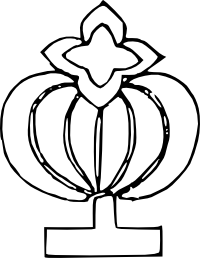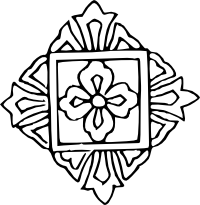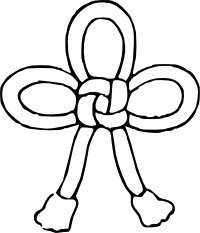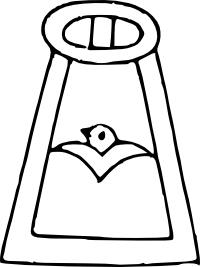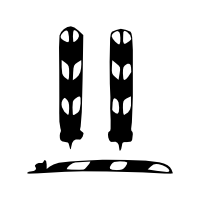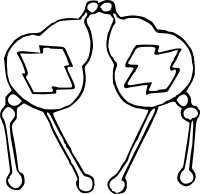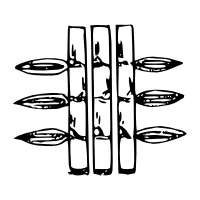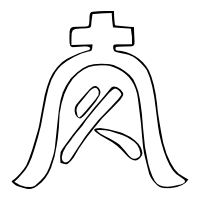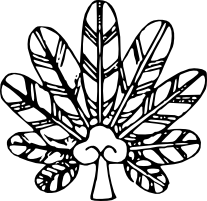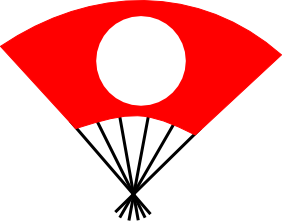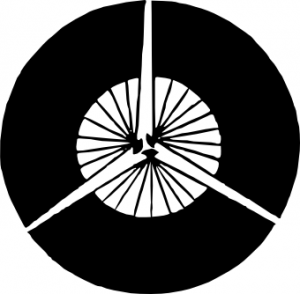Recreational research into Feudal Japan
Posts tagged provincial
Mon from a compilation of mon used by provincial samurai dating to approximately 1460–1470. See Kamon no Jiten (Encyclopedia of Family Crests), p. 7.
Primary Source: Kenmon Shokamon
Jun 5th (a Shakkō (赤口))
O-umajirushi is great for an idea of what mon were like in the Momoyama period, but what were they like before that? There are few earlier sources for mon other than depictions of battle scenes and similar. One that I have found, however, is Kenmon Shokamon (見聞諸家紋), which translates to “Various Observed Family Crests”. It’ss an excellent collection of a wide variety of earlier mon, some of which have been featured on this blog as “provincial samurai” mon. It was originally published around 1467–1470, and it features crests that were observed on the banners and camp curtains of the Ōnin War, which started the Sengoku period.(ja.wp:見聞諸家紋) It contains a variety of combinations and motifs that are rare or absent by the time of the later codifications. I recently got access to the full text of this source via Google Books and shenanigans, and it has plenty of interesting designs, featuring a wide selection of plovers and also including a phoenix, a horse, and a shrimp. It also features some unexpectedly pictorial designs that in some ways are more similar to the later Edo period designs than those in common use around the Momoyama period. Its selection of mon that combine multiple elements in different ways will be useful for those seeking to register mon in the SCA.
I haven’t had time for detailed analysis as of yet, but I present the text for your enjoyment:
Two Mysterious Mon
Dec 13th (a Shakkō (赤口))
Finishing off the provincial samurai mon, I have two flower designs that I haven’t been able to find elsewhere and haven’t figured a convincing explanation for viagra pharmacie en ligne.(KJ:7) Flower variations are probably the most common type of mon, so it’d make sense that there were variations that didn’t catch on, but the specific flowers these are supposed to be remains a mystery to me. The first perhaps is on a melon, and the second has an intricate angled square design. Maybe one of you will have some insight?
Mon of the Week: Bowl with Chopsticks
Dec 5th (a Sembu (先負))
The basic bowl-with-chopsticks design, simply a circle above two horizontal lines, was first used as a seal in ancient times. It is associated with a tale about the founder of the Narita family: faced with a battle after running out of provisions, he visited a shrine, ate the offering of rice left there, and proceeded to fight most impressively.(Dower:106) This variation, from the collection of provincial samurai mon,(KJ:7) has filled in the bowl with a simple perpendicular-lines pattern of a type used on fabric..
Mon of the Week: Knot
Nov 28th (a Tomobiki (友引))
Continuing with the provincial samurai mon, we have this simple depiction of a knot.(KJ:7)
This is not just any knot, however. This knot is called “agemaki” (総角) and auspiciously symbolizes the four directions. It is hung above sumo rings, and was used on samurai armor both for decoration and as a structural component.(Samurai Weapons) For these reasons and its graphical simplicity, it makes a lot of sense as a samurai mon. Slightly more stylized depictions continue to be used in mon today,(Kamon Composition Maker) albeit rarely.
Less relevantly, it names a similar-looking historical (but later) hairstyle and type of dance in kabuki. Nowadays, they are used to decorate cars in Japan’s “VIP style”.(Diamond Zeus)
Mon of the Week: Enclosed Goose
Oct 25th (a Tomobiki (友引))
At the other end of the spectrum in terms of realism from the Perching Hawk is this mon below, from the same collection of provincial samurai mon.(KJ:7) The highly stylized bird in the middle is a wild goose, and this depiction of geese is still common through the present day. Geese are associated with good news and gracefulness.(NHK Online) More mysterious is the enclosure around the goose. It bears some similarity to a piece of horse equipment (aori/泥障) that would hang from the saddle and sit between the rider’s legs and the horse’s body; these could be decorated with mon the way the plover image appears here. This explanation isn’t entirely convincing, so there could be other possibilities.
Note: This entry originally inaccurately identified the bird as a plover instead of a wild goose. Plovers were a common motif in Japanese poetry, with connotations of longevity based on their cry “chiyo” (thousands of generations).(Komuso)
In addition, one source identifies this enclosure as tongs.
Element of the Week: Feathers
Sep 27th (a Sembu (先負))
Today we look at a straightforward motif in mon: feathers. Generally described as hawk’s feathers (or, depending on translation, falcon’s feathers), they are graphically simple and have flexibility in number and arrangement. They have a military connotation, both from hawks being hunting birds and from the tradition of fletching arrows with feathers from birds of prey.(Kyudo) Falconry was also a popular and respected sport for both samurai and nobility from the Heian Period (794–1185).(Dower:94)
Here we have a simple 5-feather mon from the Muromachi-period collection of provincial samurai mon.(KJ:7) It shows the more free-form nature of earlier mon by being notably wider than it is tall, which became rarer as mon became more formalized.
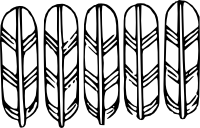 Watch movie online The Lego Batman Movie (2017)
Watch movie online The Lego Batman Movie (2017)
This even earlier mon, used by the Kikuchi family in the 14th century,(SH:14) is interesting for its use of a half feather, an unusual way of creating a distinctive mon. The same family would later use other mon incorporating an even two feathers.(en.wp:Kikuchi_clan)
Mon of the Week: Pine-bark Gourds
Sep 6th (a Butsumetsu (仏滅))
Here we have another mon incorporating the chestnut/diamond motif discussed earlier, this one from the 15th century colection of provincial samurai mon.(KJ:7) This mon uses a variation of the three chestnut design with the bottom diamond small to match the top one. This variant is called the “pine-bark diamonds” (松皮菱/matsukawa hishi),(IEJFC:352.2) for reasons that are unclear. The chestnut designs are on gourds of a type (瓢/hisago, “bottle gourd”) that was hollowed-out, dried, and used to carry water. The gourds are in turn supported by mysterious ball-ended sticks. These may be stylized vines or representations of the cords that would often be tied around the middle of such gourds to carry them. They may also represent sticks used to hit gourds when using them as percussion instruments, often for religious purposes.(EAH:Bottle Gourds)
This version of the three-diamonds motif tessellates well, and was also used as a fabric pattern in the Momoyama period (1568–1603).(JAANUS:Matsukawabishi)
Mon of the Week: Three Bamboo Poles
Sep 6th (a Butsumetsu (仏滅))
Bamboo groves are commonplace in Japan, and bamboo has long been used as a construction material and for uses such as piping (due to its hollowness) and can easily be sharpened into a spear. Here we have a different take on bamboo found in the collection of provincial mon.(KJ:7) Unlike the more popular depiction of bamboo leaves in clumps, as we saw in our recent fan with bamboo, this mon has single leaves protruding sharply at right angles from the trunks. This gives the leaves a harsher, almost spearhead-like appearance. With the minimal information given by the source, any motivation behind this depiction would be pure speculation; suffice it to say that while variations of bamboo have always been popular in Japanese heraldry and design, this particular version did not catch on.
Mon of the Week: Bell
Aug 24th (a Sembu (先負))
Today we look at another mon from the same collection of provincial samurai mon from the 15th century.(KJ:7) Today’s mon uses an enclosure that didn’t become a common element in Japanese mon despite its simplicity and elegance.
The enclosing shape appears to be a bell. Bells were associated with Buddhist temples, which used large bells to announce times for prayers, meals, and other such scheduled events in much the same way as Western churches and monasteries. These bells are struck from the outside by thick hanging wooden poles, instead of having an internal ringer and moving the bell itself with ropes.Watch movie online John Wick: Chapter 2 (2017)
The character inside is slightly mysterious despite being clearly drawn. It’s most probably a variation on 久, meaning ‘long time’, which in addition to being used in the Japanese equivalent of “long time no see” (久しぶり/hisashiburi) also has auspicious connotations of longevity.
While cross-like elements like the one present here would later be common in the mon of “secret Christians” (Kakure Kirishitan) after Christianity was outlawed in Japan, this particular mon predates such things. Here it perhaps represents a ring hanging the bell from a beam.
Similar bells would also be used as fire bells in the Edo period,(ja.wp:半鐘) when the population density and wooden construction in Edo caused frequent fires. In the peace of the Edo period, some warriors turned to serving in fire brigades summoned by such bells. More realistic, three-dimensional depictions of these bells are used in mon today.(Dower:105)
As a side note, a supposed veiled insult engraved on a temple bell is supposed to have triggered the Ōsaka Campaign,(en.wp:Bell_(instrument)) which is one good source of depictions of military mon.
Motif of the Week: Folding Fans
Jun 14th (a Senshō (先勝))
A while back we talked about one type of fan used in mon, but the type of fan everyone associates with Japan is the standard folding fan. This was a very popular motif in mon through the centuries. Its origins as a design motif date to the Heian period (794–1185).(Dower:110)
Here are two folding fans from our collection of 15th century provincial samurai mon.(KJ:7) The one on the left is a cypress fan, which was part of the traditional court costume, with the number of slats used indicating the status of the holder.(Dower:110) The one on the right is of feathers. It’s stylistically related to the hemp palm mon, and is associated with tengu, the mythical “bird goblins” who would trick mountain travelers with illusions, and from there mountain asceticism and certain temples and shrines.(Dower:111)
A simple folding fan design with the sun-circle motif was used by Satake Yoshinobu at the Battle of Imafuku in 1614, in the early Edo period.(SH:H9,62) This style of papered fan, optionally with design, became the standard version of the folding fan for mon. This particular version is interesting because it breaks the standard two-color rule for mon, which would soon become inviolate, by using three distinct colors: black, white, and red.
Around the same time, we have a three-fan design used by Matsudaira (Okochi) Nobutsua, who we mentioned last week, at the Shimbara Rebellion in 1638.(SH:63) Making circles of fans is similar to the way circles would be made of some plants in mon.
Modern fan mon are very similar to these early Edo designs, but with more realistic handles that hearken back to the earlier fans we have here.(IEJFC:52.2)
